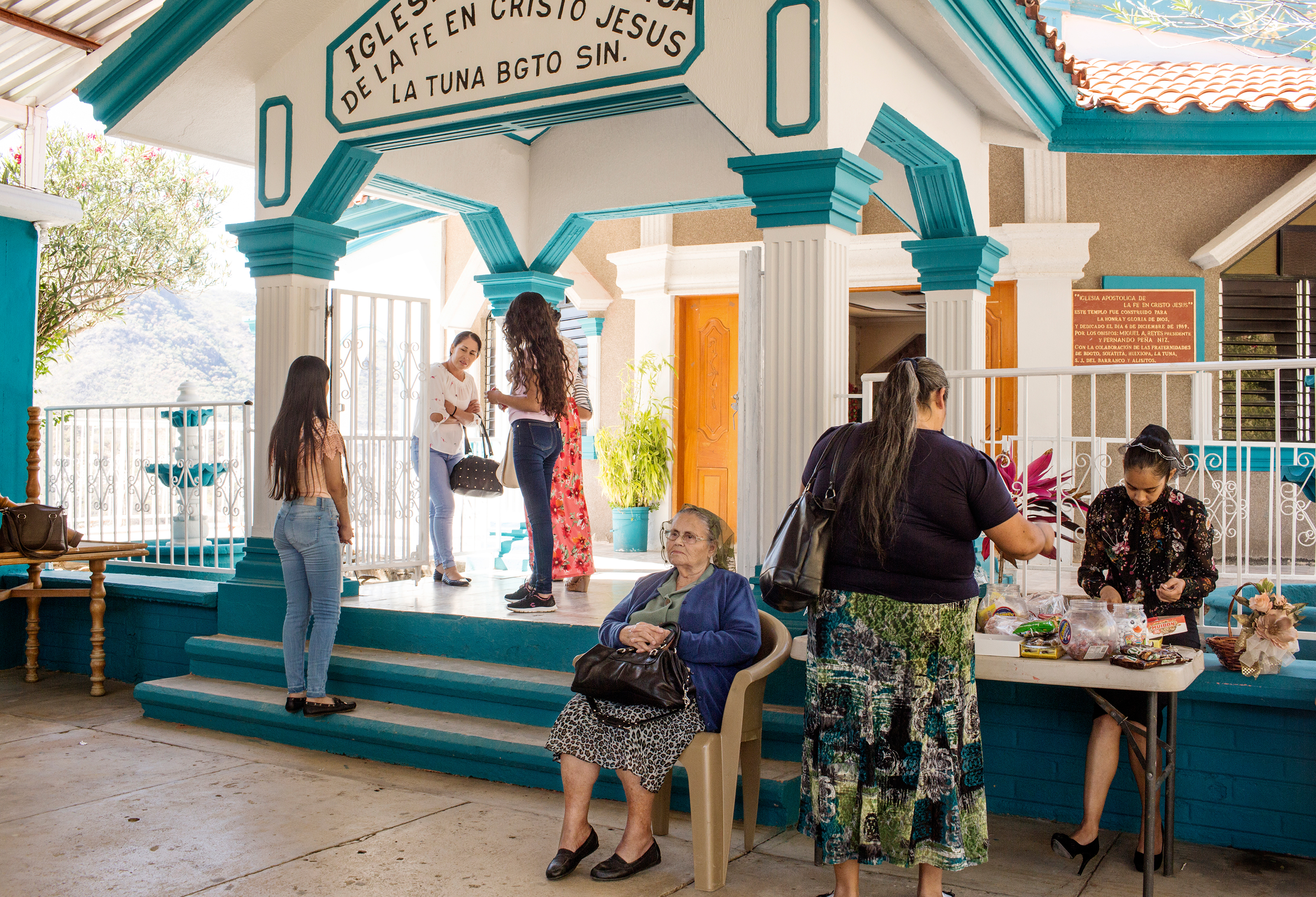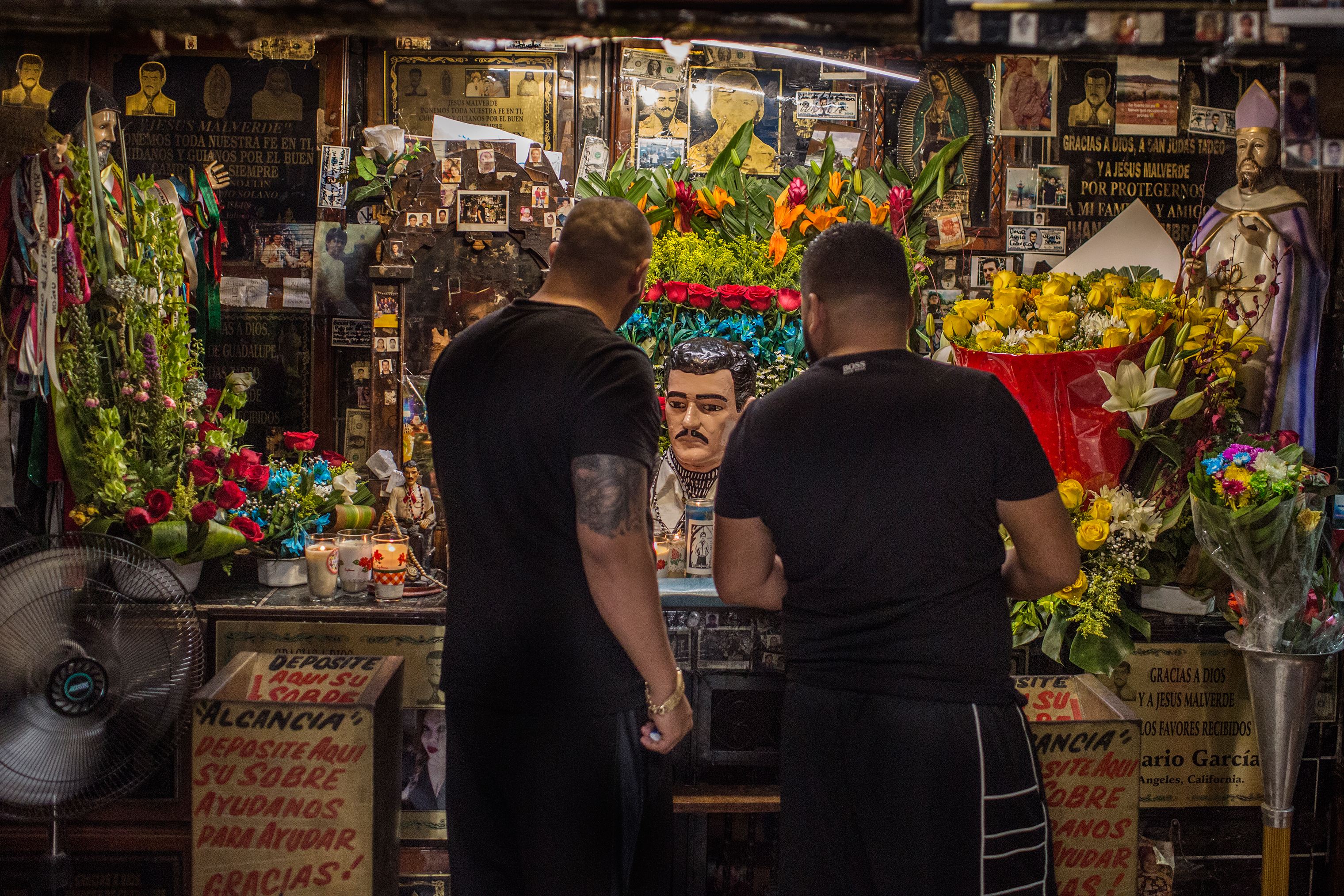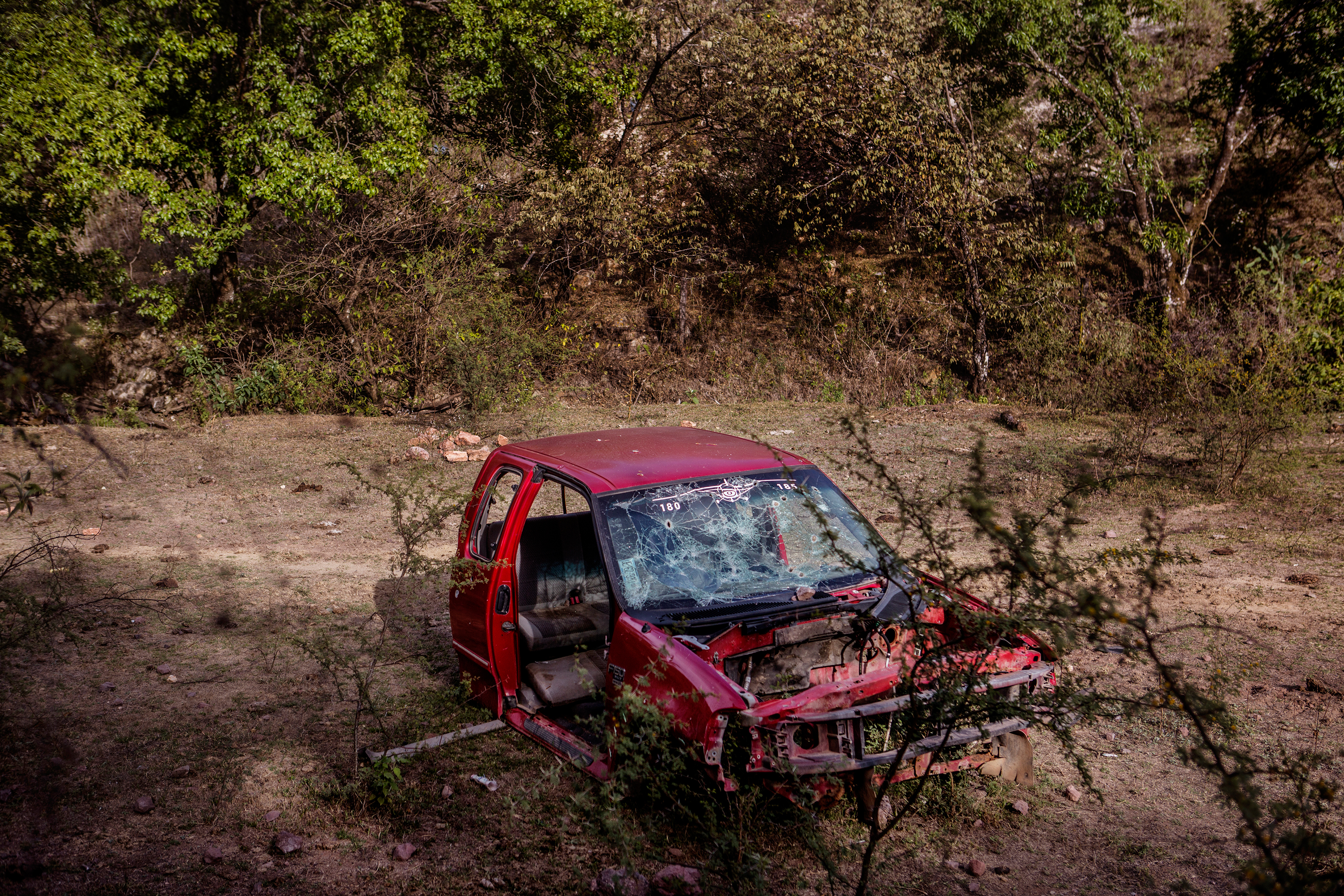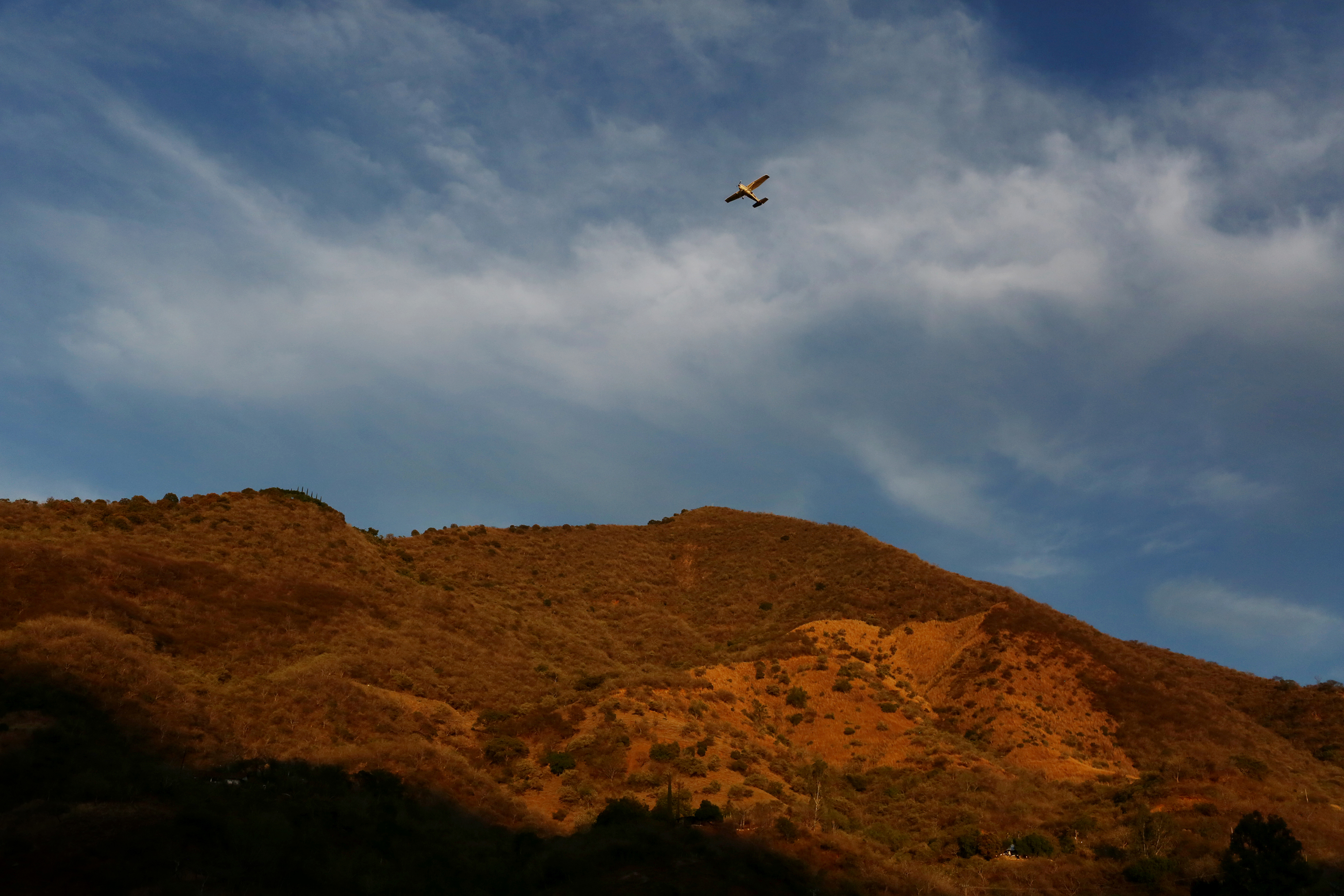When Joaquín “El Chapo” Guzmán was born in the rugged village of La Tuna in Mexico’s Sierra Madre mountains in 1957, the houses were made of mud, there was no electricity or running water and mules provided the only form of transport. His mother described how she and his father scraped by growing beans and corn on the rocky slopes to care for him and his 10 siblings. “They were difficult times. We longed for something better,” Consuelo Loera, Guzmán’s 88-year-old mother, tells TIME as she looks out at the homes and farmsteads clinging to the sun-soaked hillside. Known as El Chapo (or Shorty) for his diminutive, stocky stature, Guzmán toiled as a child to help bring food to the table, hauling sacks of oranges around the hills to sell to peasant farmers for a few pesos. “He always fought for a better life,” Loera says, “even as a small boy.”
Six decades later, Guzmán languishes in New York City’s highest-security prison, accused of trafficking drugs worth $14 billion into the U.S.—one of the biggest narcotics cases in U.S. criminal history. His mother lives not in a muddy shack but in a sprawling brick compound with guards outside on quad bikes brandishing Kalashnikovs. “I just talked to him by telephone,” Loera says. “He is putting on a brave face. He has always been someone who acts as if everything is fine.”
Loera and other locals say they hope Guzmán, who was extradited to the U.S. hours before President Donald Trump took the oath of office in January 2017, will beat the case and walk free—to return here as he did at times when he was on the run after escaping from Mexican prisons in 2001 and again in 2015. That would be quite a feat considering that Guzmán, 61, has been indicted in seven U.S. federal districts and is accused of being the leader of the Sinaloa Cartel, the murderous organization that prosecutors describe as the world’s largest and most prolific drug-trafficking organization.

But unlike dozens of other Mexican drug lords who have been extradited to the U.S. in recent years and pleaded guilty, usually as part of deals, Guzmán has declared himself innocent—prompting a trial that is scheduled for September in a federal court in Brooklyn.
The prosecution’s case, as outlined in a 56-page detention memorandum, accuses Guzmán of crimes across three decades, a span taking in six Mexican Presidents, $1 trillion in American drug-war spending, millions of cocaine highs and thousands of violent deaths. His alleged rise to become one of the world’s most notorious cartel chiefs parallels the shifting war on drugs, which was first declared by President Richard Nixon in 1971 and led to the crack wars of the 1980s, the crystal-meth scare at the turn of the millennium and the heroin epidemic of today.
It has left a trail of victims to rival any conventional war. In the U.S., there were more than 15,000 heroin-related deaths in 2016, a fivefold increase since 2010. In Mexico, the clash between rival cartels fighting one another and security forces over billion-dollar trafficking routes and other rackets is estimated to have killed more than 119,000 people over a decade. If the war on drugs were classified as a military conflict, it would be one of the world’s deadliest.
At the Brooklyn trial, prosecutors are likely to emphasize the historic links between crack cocaine and local violence. “Nowhere was the devastating impact of the introduction of cocaine into the U.S. felt more acutely than in New York and Miami in the 1980s,” they wrote in the detention memo. (Prosecutors declined to comment on the case beyond the memo.) Over the decades, drug selling led to thousands of murders in inner cities across the country, and in turn, the imprisonment of hundreds of thousands of people for possession and dealing.
The strategy of the Drug Enforcement Administration (DEA) was to move away from those low-level cases and go after the world’s biggest kingpins. Agents claim that Guzmán is the biggest of them all, the ultimate target of the DEA’s long and bloody campaign against cartels.
But while a conviction of Guzmán would be seen as a victory for the DEA and other agencies, a trial may also shine a light on dubious practices by U.S. agents and on Washington’s financial support for Mexican security forces, even as cartels pay off some Mexican police and soldiers. And it could highlight how taking down kingpins has failed to stop both the supply of narcotics to Americans and the bloodshed south of the border. In other words, it could put the war on drugs itself on trial—while the world is watching.
“It will certainly explore the tactics that drug warriors have used over the decades,” says Alejandro Hope, a former Mexican intelligence officer. “But will it change much? I am not sure.”

Along this stretch of mountains in Mexico, pink opium poppies have flowered since the late 19th century, brought over by Chinese migrants working in mines and on the railroads. When Washington first restricted opium in the 1914 Harrison Act, the illicit drug trade from Sinaloa into the U.S. was born. The poppy pickers became known as “gummers,” or gomeros, in reference to the stodgy black opium paste they extract and use to make heroin. Today many major traffickers hail from the Golden Triangle—as it’s known for its booming drug production—that crosses the Mexican states of Sinaloa, Chihuahua and Durango.
Guzmán has said he first joined the gummers when he was 15, which would be in 1972 or 1973. “There [were] no job opportunities,” he said in a video posted by Rolling Stone in January 2016. “The way … to be able to buy food is to grow poppy and marijuana, and from that age I began to grow it, to harvest it, to sell it … Drug trafficking is already part of a culture that originated from the ancestors.”
In these mountain villages, many see Guzmán as a superhero who outwitted both the Mexican government and the gringos. Songs, movies, books and TV series all helped propel Guzmán to a legendary status. Worldwide, his notoriety is comparable with that of the Colombian cocaine king Pablo Escobar. In 2013, the Chicago Crime Commission (CCC) named Guzmán as Public Enemy No. 1, the only other person besides Al Capone that the CCC has given the title. Forbes magazine added to the legend by putting Guzmán on its billionaires list for several years.
Guzmán has apparently taken steps to burnish his image in Mexico. Residents here tell stories of how he appeared suddenly at village fiestas, handing out rolls of cash to adoring crowds. “He is a leader, a hero for many people here, because he started from below, very poor, a peasant, and he helps people,” says Baldomar Cáceres, a singer and former teacher from a nearby village. “He builds roads where there is only dirt. He pays for the hospital treatment of the sick.” In contrast, the government has often failed to provide basic infrastructure for these poor, remote villages.

But Sinaloa has paid dearly for the wars raging among rival drug traffickers. The dead include not just the foot soldiers, but also ordinary people who may have witnessed their crimes or just angered the wrong gangster. In 2014, gunmen dragged away Roberto Corrales, a 21-year-old compact-disc seller in the town of Los Mochis. After police failed to find him, his mother, Mirna Nereyda Medina, joined other family members of the missing to search for burial sites. Cartel hit men often bury those they kill, leaving clandestine graves amid the hills.
Finally, in 2017, she discovered a mass grave with fragmented bones that were identified as belonging to her son. “The pain never goes away,” says Medina, a teacher. “It angers me how people make these criminals into heroes without thinking about the harm they are doing.”
Guzmán’s entry into the narco world came at a pivotal moment in drug policy. After American drug use grew with the 1960s counterculture, Nixon called for “a worldwide offensive” against street drugs in 1971. He went on to create the DEA to spearhead this war, and it soon deployed agents from Afghanistan to Colombia to go after the narcotics producers and traffickers in their homelands. Mexico was already a significant supplier of heroin and marijuana by the 1970s and became over the ensuing decades the dominant drug-trafficking power in the Americas.
Critics of the war on drugs point to the balloon effect of enforcement: when you apply pressure in one place, the air simply rushes to another place. When agents and gunboats cracked down on Colombians flying cocaine across the Caribbean into Miami in the 1980s, the smugglers turned to Mexico’s 2,000-mile border, from which the Sinaloans had long trafficked their products.
Prosecutors say Guzmán dealt directly with Colombian cocaine kings who flew the substance from the Andean jungles to Mexico in groups of planes, each carrying close to a ton of product. He would smuggle it into California, Arizona and Texas “in record time,” prosecutors say, earning him another nickname: El Rápido. He is accused of transforming tunnels, which began as natural underground rivers below border cities like Nogales, into sprawling structures with railcars and electric lights.
Mike Vigil, a former head of international operations for the DEA, who spent 13 years working in Mexico, says the Sinaloa cartel became an entity similar to a major corporation with franchises. “It mirrors McDonald’s, and Chapo Guzmán would be like the CEO. He would handle the big strategy and logistics and then allow subsidiaries to work on different elements of the business,” Vigil says.
However, a relative of Guzmán’s who asked not to be identified by name told TIME that his wealth has been wildly exaggerated. “He has power because people listen to him and trust him. But they will not find any billions,” he says. In the Rolling Stone video, Guzmán himself denied being the head of a cartel, saying, “The people who dedicate their lives to this activity don’t depend on me.”

Violence rose in Mexico starting in the 1990s as cocaine profits transformed the smugglers from sandal-wearing farmers into heavily armed members of cartels. In May 1993, gunmen shot dead the Archbishop of Guadalajara, shocking the nation. Mexico’s attorney general claimed that the assassins worked for the Tijuana cartel and were really after Guzmán. The following month, police in Guatemala captured Guzmán near its northern border and deported him to Mexico, where he began his first prison term.
Guzmán continued to run his cartel empire from behind bars, prosecutors claim, before he was said to have bribed guards to let him ride out in a laundry cart in 2001. With Guzmán on the loose, gangland violence intensified as the Sinaloa cartel battled rivals like the Zetas, former soldiers who had defected to the narcos. President Felipe Calderón launched a military offensive against the cartels in 2006, which the U.S. supported under the Mérida Initiative, a cross-border partnership to fight organized crime. Over the following decade, the U.S. gave $1.6 billion worth of aid to Mexico, including Black Hawk helicopters and wiretap gear against cartels. But the violence only intensified further as gangsters hit back against the security forces and one another, unleashing shoot-outs in city centers and leaving piles of severed heads in plazas.
The bloodiest battleground was Ciudad Juárez, bordering El Paso, which saw more than 9,500 murders over four years, devastating a generation of young men who were recruited from the slums by the cartels. Prosecutors say they will prove links between this slaughter and Guzmán, who they allege was fighting against Juárez drug lord Vicente Carrillo Fuentes. “One witness is expected to testify to the activities of one of Guzmán’s sicarios [hit men] during the Vicente Carrillo war in Juárez, including his use of a house specially outfitted for murdering 20 victims,” the memo says. “The house had plastic sheets over the walls to catch spouting blood.”
The 2014 capture of Guzmán was one of the biggest triumphs for Mexican President Enrique Peña Nieto. But the alleged kingpin’s escape the following year from Mexico’s top security prison was one of his biggest embarrassments. Officials said Guzmán left through a mile-long tunnel with a rail line. But trust in the government is so bad that one survey found only 46% of respondents believed this version; many thought he just bribed his way out the door.
In 2016, Peña Nieto regained some face when Mexican marines recaptured Guzmán. “Mission accomplished,” he tweeted. “We’ve got him.” The timing of the extradition, hours before Trump took power, was seen by some pundits here as an offering to the new American President who had pummeled Mexico in his campaign.
Now that Guzmán is on U.S. soil, a conviction would be an example to other major traffickers, says Vigil. But if he were set free, it would discourage Mexico and other countries from extraditing such criminals in the future, he says. “If they don’t get a conviction, it is going to be a big black eye on American justice.”
More than 2,000 miles from the Sinaloa mountains, a crack team of federal prosecutors in Brooklyn are preparing for a trial that could last months. Leading Guzman’s defense is A. Eduardo Balarezo, a Washington-based lawyer with a history of handling high-profile drug cases. Media attention is expected to be enormous, and the jury members will be kept anonymous for their safety.
The trial will showcase a cross-border effort to bring in the kingpin; Mexican security forces were able to arrest Guzmán with the help of U.S. intelligence. But it could also highlight the deep problems of Mexican law enforcement. Throughout the memo, prosecutors allege that Guzmán used the profits from his drug empire to buy Mexican officials at all levels. “Many witnesses are expected to testify concerning Guzmán’s payment of bribes to politicians and members of law enforcement to ensure that Mexican criminal laws were not enforced,” it says.
Sinaloa politician Manuel Clouthier, who is running as an independent for the Senate, says corruption goes deeper than has been exposed so far. “The interests of narco trafficking run to the highest level that you can imagine,” he says. “Organized crime does not exist without institutional support.”
Corruption among Mexican officials is hardly news; hundreds of police officers, generals and state governors have been charged for working with drug traffickers over the years. But exposing such dishonesty in an American court may also undermine the U.S. efforts south of the border.
Prosecutors will offer testimony from dozens of convicted Mexican and Colombian drug traffickers to explain how they worked with Guzmán to move tons of cocaine, heroin, marijuana and crystal meth into the U.S. and carry out mass murder south of the Rio Grande. Balarezo tells TIME that he will question the credibility of these witnesses, who he says could have made deals for lower sentences in exchange for their testimony; he also plans to challenge the broader tactics of American agents in their decades of following Guzmán.

In previous controversies, to try and build conspiracy cases against major targets, members of various agencies have been found paying informants who are actively committing serious crimes and letting thousands of guns be trafficked to killers. “Some of the ways that the DEA operates abroad are unethical or illegal,” Balarezo says. “They are walking a thin line and sometimes stepping over it.”
Officials from U.S. Customs and Border Protection have also been convicted of taking bribes to let drug loads through over the years. And there have been scandals over the techniques of American agents fighting cartels. In 2004, journalist Alfredo Corchado exposed how U.S. Immigration and Customs Enforcement had a paid informant involved in murders in Juárez. In 2011, the Bureau of Alcohol, Tobacco, Firearms and Explosives was heavily criticized for failing to act as it watched nearly 2,000 guns be purchased in Arizona for Mexican cartels.
That history may be exploited by the defense in Guzmán’s case. In 2011, Sinaloa trafficker Jesús Vicente Zambada filed a motion in a Chicago court saying he could not be prosecuted because he was a DEA informant in a wider deal between the Sinaloa cartel and U.S. agents to take out rivals. That alleged deal could factor into the Guzmán case. “When we go to trial, a look at the meetings between the DEA and drug traffickers is definitely fair game,” Balarezo says.
However, the security expert Hope says any exposure of DEA tactics may be more “embarrassing” than “earth shattering.” “My guess is it will confirm many people’s biases,” he says.
The defense also faces daunting challenges. The Metropolitan Correctional Center, where Guzmán is held, is one of the U.S.’s harshest prisons, and high-risk inmates are kept isolated under glaring fluorescent lights. “His memory is deteriorating,” Balarezo says. “He is isolated 23 hours a day, and we can only see him in a tiny little room with a glass screen.”

In another twist, the actor Sean Penn and Rolling Stone could play a role. Following the last arrest of Guzmán, in the Sinaloa town of Los Mochis in January 2016, the magazine published a story by Penn in which he described how he and Mexican actor Kate del Castillo met Guzmán in the mountains while he was on the lam. It also released a video of Guzmán answering questions and describing some involvement in the drug trade. Vigil says the video could be vital evidence. “You have him on tape clearly confessing that he is involved in drugs.” In an interview, Penn told TIME he wasn’t concerned for himself about the footage being used. “That’s a video that [Guzmán] voluntarily made and sent,” he says. “Those are decisions he made.”
In the mountains of the Golden Triangle, the trial will be watched closely, especially by the young men who idolize Guzmán. Village shops even sell baseball caps that feature the words Chapo and C.D.S., meaning Cartel de Sinaloa. Despite the decade-long military offensive against cartels, gunmen still move openly in these remote heights. In February, TIME witnessed men roaming around in combat gear and ski masks holding up rifles.
The huge effort to capture Guzmán and put him on trial has failed to stop the Sinaloa Cartel from recruiting a new generation. One group of youths stand on a ridge above the road bearing guns and speaking into radios as they take note of vehicles going by; they are known as halcones, or hawks, a role that the traffickers often fill at the beginning of their cartel careers. Without a more effective counter to the drug trade, the kingpins of the future could be among them. — With reporting by Miguel Ángel Vega/La Tuna and Nate Hopper/New York
- How Donald Trump Won
- The Best Inventions of 2024
- Why Sleep Is the Key to Living Longer
- Robert Zemeckis Just Wants to Move You
- How to Break 8 Toxic Communication Habits
- Nicola Coughlan Bet on Herself—And Won
- Why Vinegar Is So Good for You
- Meet TIME's Newest Class of Next Generation Leaders
